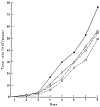Development of functional foods
- PMID: 25032085
- PMCID: PMC4098653
- DOI: 10.12938/bmfh.33.117
Development of functional foods
Abstract
Recent advances in intestinal microbiota research are the background for the appearance of functional foods. Lactic fermentation products are included in the functional foods and classified into 3 groups based on their mechanisms of action: probiotics, prebiotics and biogenics. Probiotics are viable microorganisms, such as lactobacilli and bifidobacteria, that beneficially affect the host by improving the intestinal bacterial balance. Prebiotics are nondigestible food ingredients, such as oligosaccharides and dietary fiber, that beneficially affect the host by selectively stimulating the growth or activities of beneficial intestinal bacteria in the colon and thus improve the health of the hosts. Biogenics are biologically active peptides, including immunopotentiators (biological response modifier: BRM), plant flavonoids, etc. They act directly or indirectly through modulation of intestinal microbiota on the health of the hosts. Thus, functional foods enhance bioregulation such as stresses, appetite and absorption; biodefence, such as immunity and suppression of allergies; prevent diseases, including diarrhea, constipation, cancer, cholesterolemia and diabetes; and suppress aging through immunostimulation as well as suppression of mutagenesis, carcinogenesis, oxidation processes, intestinal putrefaction, and cholesterolemia.
Keywords: functional foods; intestinal bacteria; intestinal bacteriology; intestinal microbiota.
Figures















References
-
- Japanese Ministry of Health and Welfare, editor. Kosei hakusho, Showa Health and white paper (1985) p. 1. Kosei Tokei Kyokai [Association for Health and Welfare Statistics], Tokyo (2013/14).
-
- Metchnikoff II. 1907. The prolongation of life.Optimistic Studies, Springer, New York.
-
- Rettger LF, Levy MN, Weinstein L, Weiss JE. 1935. Lactobacillus acidophilus and its therapeutic application, Yale University Press, New Haven.
-
- Henneberg W. 1934. Zur Kenntnis der stäbchenförmigen Milchsäurebakterienarten. Zbl Bakt Hyg II 91: 102–135
-
- Mitsuoka T, Kaneuchi C. 1977. Ecology of the bifidobacteria. Am J Clin Nutr 30: 1799–1810 - PubMed
Publication types
LinkOut - more resources
Full Text Sources
Other Literature Sources
